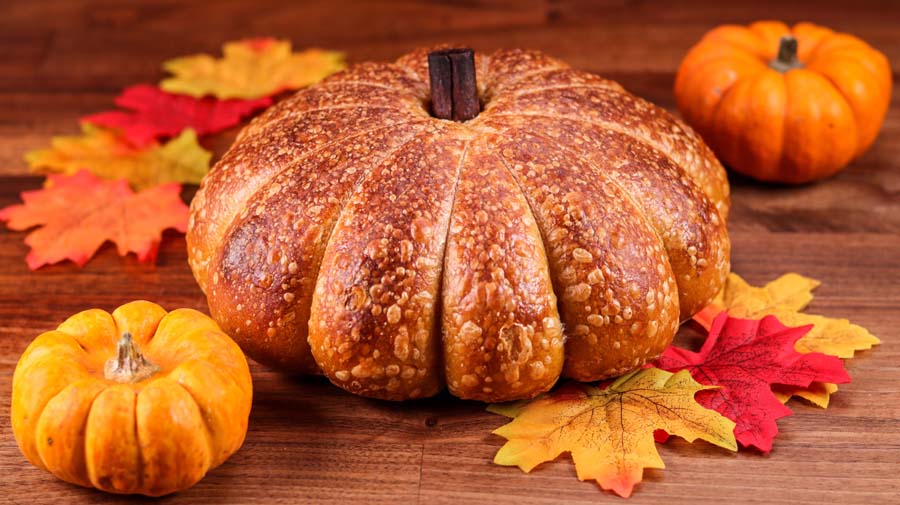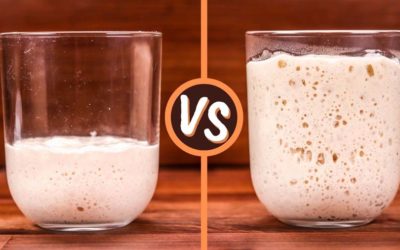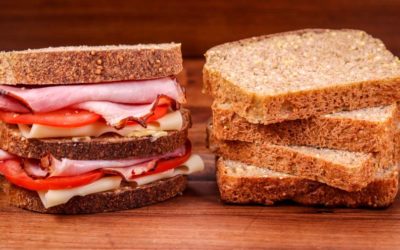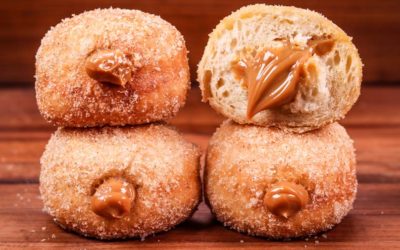This sourdough pumpkin bread looks like a real pumpkin, and it is made with pumpkin puree, so it tastes like one too. I will show you how to make a perfect pumpkin loaf for Halloween.
Using cooked pumpkin instead of water in the main dough gives it an orangey-brown colour and a subtle pumpkin flavour. Pumpkin is 90% water, so the total hydration of this loaf comes to about 67%. This is the sweet spot as you get a soft loaf with a moist crumb which is still easy enough to work with and handle.
You can modify the recipe and bake the bread on the same day if you wish or you can cold proof it for up to 24 hours, which is what I did.
Making the bread look like a pumpkin takes only a few pieces of butcher’s string. But although it may sound simple there is one thing to pay attention to. Do not tie the wrong ends together. It may seem funny, but I did this. The best way to avoid this is by picking up two ends of string and moving them back and forth to see if you are holding on to the same piece of string. You know what I always say – I make the mistakes, so you don’t have to!
You can find butcher’s string and all the other equipment I use in my videos in my Amazon shops linked below.
I have been keeping my sourdough starter at 80% hydration lately. It used to be at 100%, but now I have found that the lower hydration makes it more predictable and forgiving. I feed it once a day every evening before I go to bed. That way it is always happy and active. One feeding per day is sufficient in my opinion although I used to feed it twice a day.
To keep your starter happy and healthy you should use good water. My started does not like tap water so I use filtered water.
When making the final dough do not use regular table salt as it can contain chemicals that mess with proper fermentation.
So, if you have been having trouble with your naturally leavened bread, then perhaps one of these tips may help you. To find out more about starters check out the Sourdough Starter playlist on my channel or the Sourdough Bread page on my website.
Watch the video down below for detailed instructions.
Ingredients
For the leaven –
100g (3.5oz) strong white bread flour
80g (2.8oz) water at room temperature* if your kitchen is between 20C – 23C (68F – 74F). If it is cooler or warmer you may need to adjust the water temperature to compensate.
20g (0.7oz) active sourdough starter
*To learn more about dough temperature control click here.
For the main dough –
350g (12.35oz) strong white bread flour
9g (0.31oz) sea salt
250g (8.8oz) cooked mashed pumpkin, cooled down in the fridge.
1 egg for glazing
Method
- Cook the pumpkin. Peel and dice pumpkin in 2.5cm (1in) pieces. Cover with foil and roast at 190C (375F) for around 1 hour or until completely soft. If it is a bit grainy, then cook it for longer. Mash the pumpkin and leave to cool down completely in the fridge. It must be 250g of cooked weight so you will need about 300g to begin with.
- Make the leaven. In a small bowl combine the water, sourdough starter, and flour. Mix well until there is no dry flour left. Cover and ferment for 12 – 16 hours or until almost tripled in volume. *If you are not ready to make the final dough by the time the leaven has risen, then simply pop it in the fridge to slow down fermentation and use it when you are ready. I do this all the time when making mid-week sourdough. It gives great flexibility with naturally leavened bakes. Note that the cold starter will affect the final dough temperature so you will have to compensate with either warming up the mashed pumpkin or taking the leaven out of the fridge and letting it come up to room temperature. There are 100 ways of doing anything, I just want to give you options. To learn more about dough temperature when using a preferment click here.
- In a large bowl combine the pumpkin and salt. Mix well to dissolve the salt. Add the leaven and the flour. Mix until there is no dry flour left.
- Tip the dough out on your table and knead it for around 8 minutes. *Desired dough temperature 24C – 25C (75F – 77F). If your dough is warmer, then it will ferment more rapidly. If it is cooler, then it will take longer. Adjust proofing time accordingly.
- Cover and ferment for 2.5 – 3 hours.
- Fold.
- Ferment for 2.5 – 3 hours.
- Shape into a ball. Place in a cloth-lined bowl or a proofing basket with the smooth side down.
- Now you can choose whether to bake it on the day or cold proof it. To bake it on the same day leave it to proof for around 2 hours. Alternatively cold proof it for up to 24 hours, which is what I did. *One hour before baking preheat your oven and your baking vessel to 220C (430F) fan off.
- Lay down 6 lengths of string on a piece of non-stick paper with even gaps between them. See the video. Invert the dough onto the string. Brush it with egg. Tie the strings. Do not tie them too tight or too loose. You should be able to stick one finger between the string and the loaf. Poke a cinnamon stick in the middle of the loaf to make it look like the pumpkin’s stem.
- Place the loaf in the pan and bake with the lid on for 20 minutes. Remove the lid and bake for another 20 minutes. If you do not have a pan with a lid, then bake the loaf at a lower temperature of 210C (410F).
- Leave to cool down and remove the strings.
Cut a wedge off and serve it alongside some hearty soup or just use it as a beautiful decoration.
Keep in mind that the conditions in each kitchen are different, so fermentation times may vary for you. It is up to the baker to control the bread and react accordingly.
Your oven may be different too, so your baking time may vary.
Watch the video here



